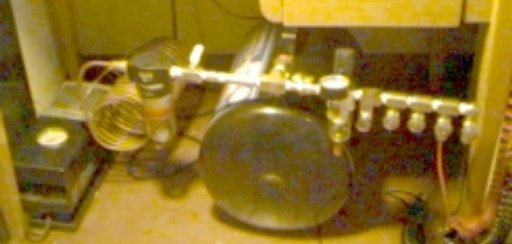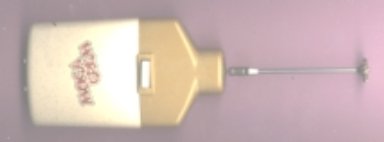Although some are necessities , others fall in the "nice to have" category. These can run from paper towels to extremely expensive spray booths with amenities . Additional costs can skyrocket. Too often misleading hype is an influence.
Some "bare" airbrushes come without hoses, while on others size is below the practical minimum of 1/8" for maintaining nozzle pressure with larger tips. Unfortunately couplings differ, but adapters are available for most. Material is usually plastic or heavier, braided cloth, covered neoprene for heavy duty use. Lengths are usually less than 6', but longer can be specially ordered. During pass motion, the weight of the hose can swing like a pendulum, twisting the airbrush in the fingers. By draping it over the wrist to support it, this can be eliminated. Some hoses are coiled to shorten effective length. but the spring action may interfere with delicate work. With the addition of other accessories, extra hoses with various fittings may be required , most of which may be found at better hobbyshops, but trips to the local plumbing supply may be required to change gender.
Air supplies come in many forms. Eliminating the need for moisture traps, pressure cans with adapters are frequently found in sets. Compatible replacements are available from Badger and Paasche in small and more economical large sizes. They should be bought in pairs, since evaporation of liquid lowers temperature, which in turn reduces evaporation and thus pressure. Swapping cans will permit the cold one to warm to room temperature. Interchangeable adapters provide a crude pressure regulation. At a comparable price, the more rugged Paasche 3B provides better adjustment than the Badger. Initially inexpensive, long term extensive use soon adds up to and surpasses the cost of alternate sources.
Refillable gas tanks (ie. scuba) are expensive and often provide excessive pressures, which can not be reduced by common airbrush regulators. Requiring a moisturetrap, 50 psi Garden sprayer tanks can be adapted, if you need exercise. As with all expendable air supplies, careful attention to minimum produced pressure is required.
More common sources are compressors found in most hobbyshops. The lower priced models are very noisy and both diaphragm and piston types produce pulsating pressures. With only pressure limiting, bleeder valves no adjustable regulation is provided. A regulator /moisture trap is essential. Tests show that gauge needle fluctuates considerably with larger flows at 30 psi or less. They do not supply enough pressure to operate air erasers or blasters efficiently. Lacking pressure cutoff switches they are not readily adaptable for storage tank usage. By adding about 10' of softer plastic tubing between compressor and regulator, pulsations can be absorbed, rivaling a tank. More exorbitantly priced "quiet" models are somewhat better, but still lacking and hardly worth the price. If included, tanks are too small for extended usage also regulators and pressures are frequently inadequate for some uses. If space is available large tank compressors work excellently with regulators and moisture traps. They are extremely effective alarm clocks at 3 AM, if imperceptible air leaks occur and switching off power is overlooked. With larger tanks, days or weeks of spaying, without recharging, are possible. One hindrance is that the hot air at the compressor input absorbs moisture from surrounding humid air, which later condenses after the output as air cools. Usually distances between compressor output and tank are very short with no trap. Condensation takes place in the tank, where often a large volume of water is collected, requiring frequent draining or possibly causing rust, if interior is not coated.
Often combined, regulators and moisture traps are essential to critical spraying. At minimum the pressure gauge should be legibly calibrated to 1 psi within the range of pressures used. The adjustment should provide easy, fine settings. Especially in humid environments,a moisture trap should have a large bowl, to avoid frequent emptying. In addition to water, filtering abilities should include dirt and compressor oils without clogging. Although expensive, the Paasche R-75 meets the requirements excellently.
Since I often use 70 psi for blasting brass, an alternative was required. Research of the market finally yielded a plausible solution, using a collection of odd parts. Tucked under the booth desk, a noisy, 125 psi adjustable cutoff, tire pump is connected to a 5 gallon 125 psi, portable "bomb" tank, through a 10' coiled, copper tubing, cooling condenser and moisture trap, to eliminate water in tank. A shut-off valve is included to prevent tank discharge back through compressor, when off. A TEE fitting serves as input-output to tank and also supports trap, valve and output manifold. The tank's regulator with gauge drops pressure to that usable by the output R-75 regulator /moisture trap. (Belt and suspenders.) To avoid swapping hose connections, the manifold consists of 5 valves, one of which controls a blow gun. It takes a noisy eight minutes to charge an empty tank, which can provide hours of spray painting when fully charged. Excluding R-75 and manifold, total cost was less than $90.

Note: Adjust brightness and contrast for optimum viewing.
ASSEMBLED AIR SUPPLY
Just visible behind TEE is the tank pressure knob.
To the right of knob is the gauge.
Most artist airbrushes are supplied with color cups, which provide quick changes of small quantities of medium. They are normally filled with a large brush or a medicine dropper. Even without cleaning between color changes, they are useful for weathering. While some are fixed, more desirable are those friction mounted in bushings on brush body. For larger quantities, various sized, friction mounted, bottle adapters are offered. With no standard, most are not interchangeable among brands or different models in the same line. Binks are compatible with Paasche H. Varieties of built-in bottle caps are available to fit most common paint bottle sizes. Often the mounting tubes are offered with various bends to permit different vertical attack angles, while maintaining optimum siphon position at bottle bottom. Substitution of a portion of siphon tube with a length of flexible plastic tubing can accommodate different depth bottles with the same lid size. Most bottles are glass, but plastic and metal are offered for more rugged use. Requiring special body mounts, some adapters have screw-on locking to prevent accidental loosening. Expensive spare bottles are available, but cleaning and saving emptied ones or finding food or other bottles will be thrifty, especially for mixing. Since in many adapters caps are affixed with a nut, with minimal work, different sized lids can be substituted.
Mixing paint thoroughly to distribute pigments and vehicle; and eliminate suspended particles is crucial to good finishes. The time honored method is to stir with any stick handy, including screwdrivers; which may be time consuming or fatiguing. Too often hidden streaks of contrasting colors create beautiful marble effects, which are not too prototypical. For the lazy or impatient, small battery operated rotary mixers, with agitators similar to those on milkshake mixers, are available. They do a good job in stirring up mud in jar bottom but frequently produce lumps, bubbles or foam. Lumps can be broken with a stick, while bubbles can be punctured, but foam must be wastefully decanted, To hurry things along, you may steal larger versions from your wife's kitchen, but they often splash paint from smaller bottles. The Mabuchi like motor should be lubricated with a Labelle 108 equivalent. As with a stick, cleaning is messy and wasteful. Common in paint stores, small shakers are available in battery eater or AC models. They are excellent mixers, but do not stir up mud or break up large lumps well, without the aid of the stick. Extremely long run times may succeed. Application of light grease improves operation and reduces noise.

Note: Adjust brightness and contrast for optimum viewing.
SMALL KITCHEN MIXER

Note: Adjust brightness and contrast for optimum viewing.
ROBART AC PAINT SHAKER
Regardless of the extent of mixing, some stubborn large particles may be suspended and certainly will clog something. Straining or filtering is often required. In the past this was often done prior to loading spraying container. More recently small cylindrical strainers with mesh side surfaces were developed to slip over bottom of siphon tube. Often due to excessive length to provide more surface area, air exposed paint dries on portions above paint level and clogs mesh. Frequently this is very difficult to clean. Shortening and thus reducing surface area, will increase possibility of clogging, when fully immersed , but wet paint is far easier to clean. By use of flexible tubing, cylinder can be laid on its side and act as a klunker to keep it immersed. A more effective shape might resemble a football.
 Caution:>After a lengthy spray
period with darker pigments, blowing the nose will reveal a dark color in
the mucus, not to mention dark phlegm in sputum. This should convince
anyone of the value of a filtering spray mask. Less expensive ones use
paper filters. To eliminate fumes, more expensive types have various
chemical filled canisters. This is not the place to skimp, if you value
your health. Better hobbyshops and paint suppliers stock these.
Additionally, eye protection should be considered.
Caution:>After a lengthy spray
period with darker pigments, blowing the nose will reveal a dark color in
the mucus, not to mention dark phlegm in sputum. This should convince
anyone of the value of a filtering spray mask. Less expensive ones use
paper filters. To eliminate fumes, more expensive types have various
chemical filled canisters. This is not the place to skimp, if you value
your health. Better hobbyshops and paint suppliers stock these.
Additionally, eye protection should be considered.
After spraying the walls, floor and the surrounding area and discovering overspray dust coating horizontal surfaces, it may be evident that some retainer is necessary. Shields and boxes help but are often inadequate. A SPRAY BOOTH _ can solve these and other problems. But most of those offered are very deficient in many desirable factors and exorbitantly priced at well over $250. Understanding the functions and characteristics will not only improve selection but provide incentive to roll your own superior booth at a great saving.
Unless continual use requires frequent bristle brush rinsing, rinse fountains are very wasteful, since solvent cleaners usually evaporate rapidly. Spray cleaning collectors are superfluous, since cleansing spraying into booth causes no problems and exhaust removes fumes.
To eliminate the necessity of throwing airbrushes on bench tops, many sets include bench side mounted holders. Badger offers a convenient bench top-mount or varied position clamp-on, two brush holder. The wire rests may require bending to accommodate some brushes.
A small yard sale, metal pantry cabinet, placed next to booth, can store paints, thinners and sundry items. Top can support items like toaster oven. To avoid leak damage, polyethylene food containers are very useful. At the bottom, large high sided ones can hold thinner cans with added protection. Storing paint jars, lid down, will provide a better seal, reducing thinner evaporation.
To avoid painting fingers, specialized PAINTING HOLDERS _ are very useful for brushing or spraying. Variety is wide, if not selection. Since the goal is to have access to every paintable surface, they must be mobile. Some are hand-held, others are free-standing; rigid or pivoted. If all else fails, you fingers in plastic gloves can handle anything.
BACK TO PAINTING AND COATING
BACK TO METHODS INDEX
